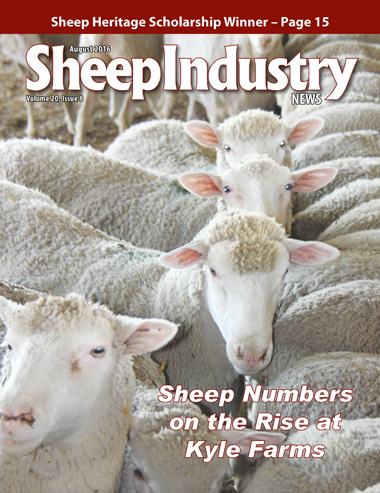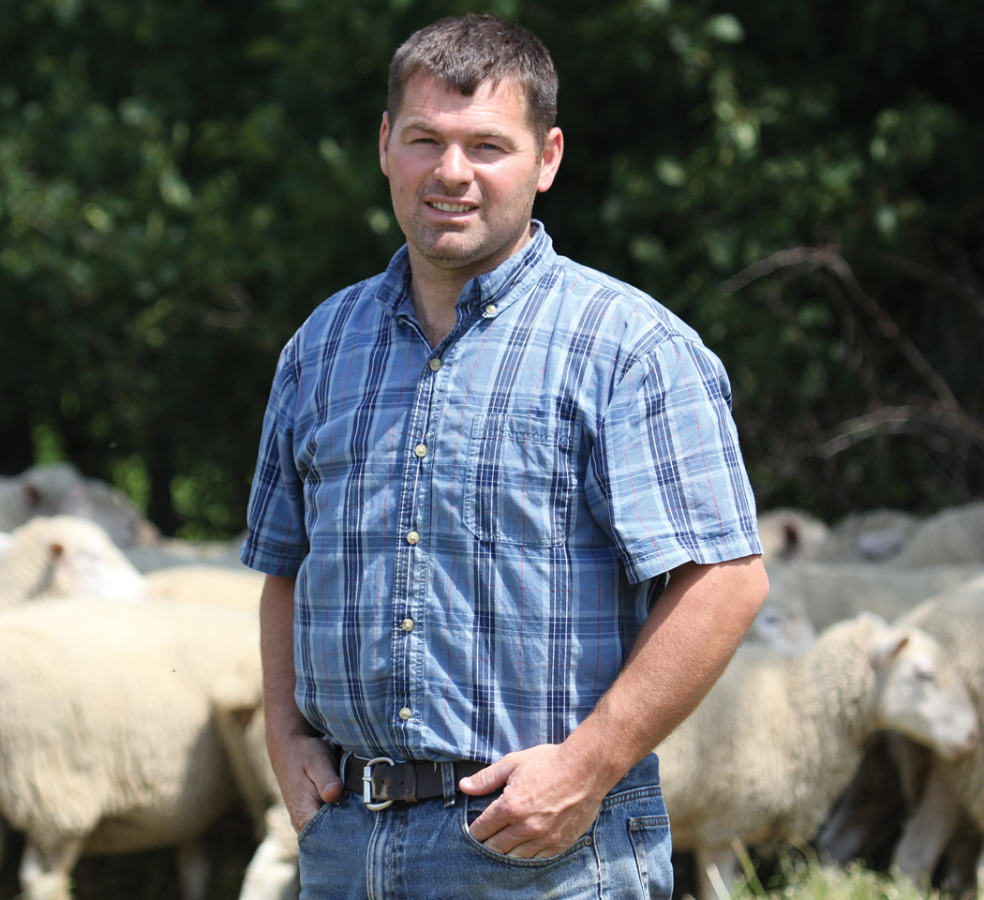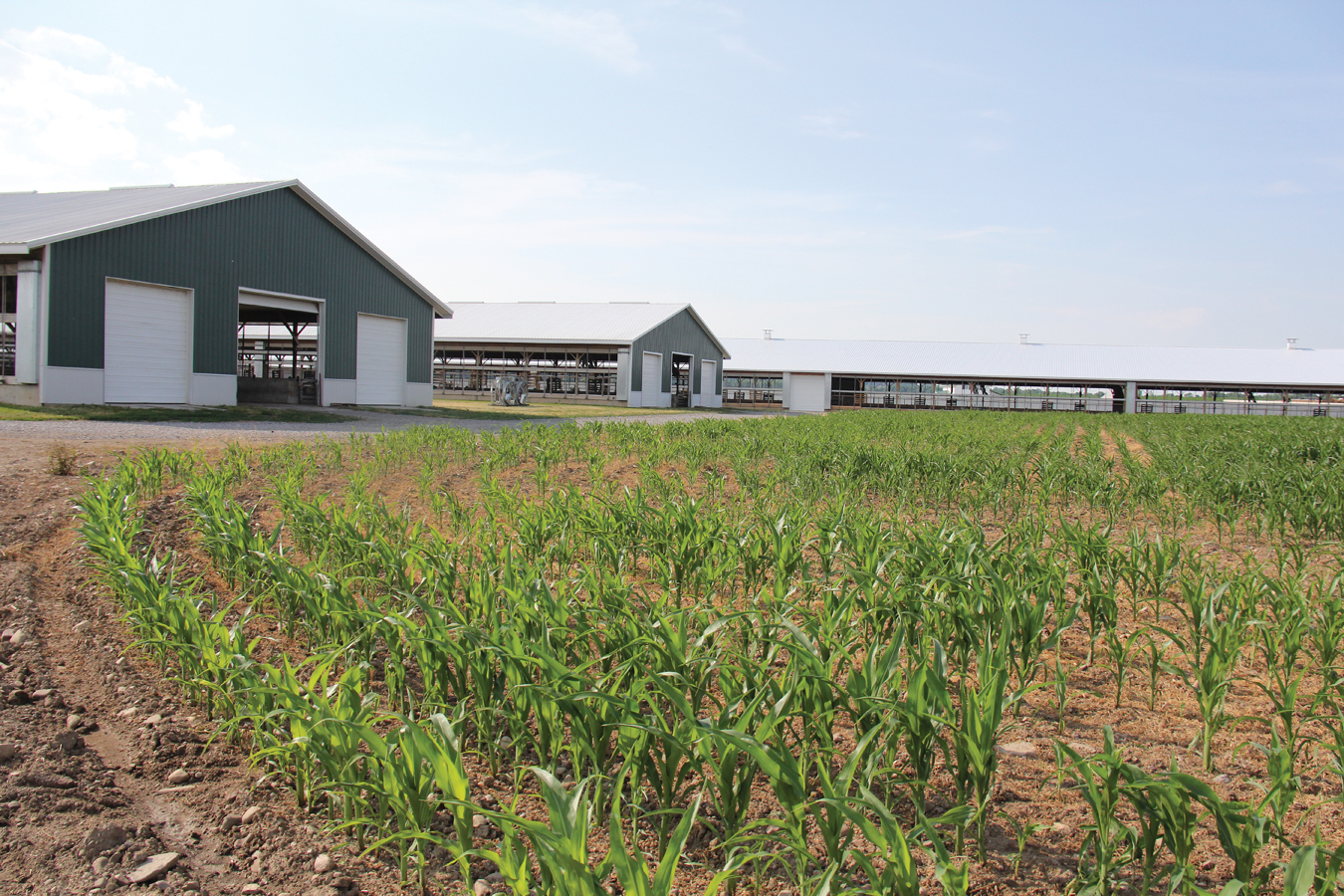
- August 2016
- President’s Notes
- Reverse Trade Missions Spur Wool Sales
- Population Explosion at Kyle Farm
- Wool Council Conducts Yearly Meeting
- No Transparency in Fed’s Sage Grouse Plans
- Posbergh Earns Foundation Scholarship
- Photo Contest Deadline Approaching
- Cuba Open to US Meat
- Q&A: Montana Sen. Steve Daines
- Around the States
- Market Report
- The Last Word
Population Explosion
KYLE PARTAIN
Sheep Industry News Editor
There’s been a sharp population spike in Avon, N.Y., in recent years, but you won’t find proof of it among the U.S. Census numbers. To see it first hand, you’ll have to visit Kyle Farms, where the ewes find themselves on an accelerated breeding program that is the talk of the industry.
 It’s not everyday you can head east of the Mississippi River and find a sheep producer running 3,400 ewes. But that’s exactly what they’re doing at Kyle Farms, a family-run operation that has taken giant leaps forward under third-generation producers Matt Kyle, his brother, D.J., and their cousin, Nathan Hatch.
It’s not everyday you can head east of the Mississippi River and find a sheep producer running 3,400 ewes. But that’s exactly what they’re doing at Kyle Farms, a family-run operation that has taken giant leaps forward under third-generation producers Matt Kyle, his brother, D.J., and their cousin, Nathan Hatch.
Getting to the types of numbers not seen in recent memory in western New York has been a challenge, but Kyle Farms is readying for even more challenges in the years to come: such as reaching 5,000 ewes, maybe more.
“I don’t think 5,000 is the end for us,” says Matt. “I really don’t. If we can continue to do a good job with the ewes, there’s plenty of opportunity around here.”
Out of season lambing. Accelerated lambing. To many producers, they are industry buzz words or vague ideas that don’t yet hold much weight. At Kyle Farms, they are words to live by. Lambing starts in January and happens again in March, May, July, September and November.
“We really like lambing around here,” Matt says with a rare smile. “If you’re going to be a sheep farmer, you have to enjoy lambing. It’s go time around here, so you know that you always have work in front of you that day. Some people don’t want to deal with lambing, so they buy from us and feed the sheep out. It works great for us because we like lambing ewes. With the facility we have, we feel that’s what he have to do to justify these buildings.
“The best part is pulling the sheep out of the lambing pens and putting them into the mixing pens. From there, your job isn’t done, but you know you’ve done a good job with them when they get to that point. Then, it’s time to wean.”
Weaning quickly and efficiently is important because Kyle Farms raises “hot house” lambs and prefers to ship them off to lucrative East Coast markets at anywhere from 40 to 60 pounds. Matt says they’ll feed a few to 100 pounds or more, but that’s not the ultimate goal.
“The reason for this setup is to have a consistent supply of lambs that can be marketed at any time after weaning,” he says. “That’s where we’re different from the people west of the Mississippi River. We have to be able to sell that lamb any day after weaning to compete in the sheep industry.”
Paired with 1,500 acres of pasture, Kyle Farms uses three vast barns with influences from the swine, poultry and dairy industries to provide optimal conditions for accelerated lambing. Barns one and two are 6 years old and measure 68 feet by 432 feet and can house up to 800 ewes each. The third was built in 2015 and stands at 68 feet by 636 feet. It’s capable of housing up to 1,200 ewes. Insulated roofs, high-tech ventilation systems and climate control keep the sheep comfortable regardless of the season.
Previously operating out of a handful of barns that could hold between 100 and 200 ewes, farm operators decided to demolish them in favor of a new barn. Construction began in July 2010 on the first barn (which now stands in the middle of barns two and three). Just as the first barn neared completion, tragedy struck.
“It was a bad day when we decided to build barn two,” Matt explains. “We went out to the pasture in November of 2010 and found a bunch of coyote kills. Within 15 days, we’d decided to build the second barn. We had it up and running in the middle of January (2011).”
The largest of the lot, barn three didn’t come along until last year. The five years between the building of barns two and three allowed Kyle Farms to identify the sheep that would best fit their program before starting an aggressive expansion.
“The barns are built to lamb ewes,” Matt says. “They are expensive barns to just be feeding sheep in. But with accelerated lambing, we have to make sure these ewes don’t skip a beat. Feeding is 90 percent of that in my opinion. Some people will argue the role of genetics in that, and there’s no doubt it plays a part. But the sheep have to be in good health and well fed to get pregnant and carry those lambs to lambing.”
The farm was routinely running close to 2,000 ewes when Matt returned on a full-time basis. But he knew increased numbers were the way to make the operation profitable. The farm was already lambing on an eight-month interval, which meant they needed to get creative to increase numbers.
 “We wanted more ewes, but we didn’t need more work during what was already our peak lambing time. So, then it was, ‘How do you spread it out?,” Matt says. “What we’re doing is taking another set of ewes and running them two months behind the first set. The flock that lambs in January skips May and lambs again in September, then skips January and lambs in May. It isn’t perfect because not every ewe is on a perfect eight-month cycle.
“We wanted more ewes, but we didn’t need more work during what was already our peak lambing time. So, then it was, ‘How do you spread it out?,” Matt says. “What we’re doing is taking another set of ewes and running them two months behind the first set. The flock that lambs in January skips May and lambs again in September, then skips January and lambs in May. It isn’t perfect because not every ewe is on a perfect eight-month cycle.
“Now, we’ve just built another set of ewes that lambs two months behind the second set. So, we’ll be lambing in January, March, May, July, September and November, and then we start it all over again in January.”
With just Matt, Nathan and two laborers working regularly at Kyle Farms, tracking genetics and other tedious tasks are rarely the top priority. But there are some observations they’ve made through the years.
“We’ve done some trials with different age groups,” Matt says. “It always seems that the second lactation, second lambing ewes are going to slip a little bit getting rebred. I’m not sure their body is used to all of that. We have no problem breeding those ewes and lambing the yearlings in May and breeding them back in January. It’s lambing them in January and breeding them back for September lambing that is the problem.”
Big believers in the value of quality feed, the farm owners work with a nutritionist to develop the feeding program that allows ewes to gear up for lambing and then once again after weaning.
“We’ve got to make sure they have enough body condition to go through the weaning process, because you’re going to have to shut down milk production,” Matt says. “As soon as the dry off is complete, you want them on a positive energy balance. It’s one of the most important things going into a breeding season. You look at athletes, they have to be healthy and strong to perform. It’s the same with the sheep. We need them to by cycling and get bred.
“In gestation, we really focus on energy. We want the ewes to have plenty of energy. Obviously, it’s all balanced with minerals. In lactation, we want to focus on protein to get milk production up. At weaning, we want to slow everything down. Post weaning, we need to speed it up a little bit. I’m not a nutritionist. We could go back to the old days where we throw them a five-gallon bucket of corn and dry hay. But this is pretty important. Primarily, we feed grass alfalfa and corn silage if they aren’t out on pasture.”
While the numbers continue to rise, that isn’t the main goal for Matt and the family-run operation.
“First we hit 1,000, then it was 2,000,” he says. “Now that we’re at 3,000, we have to stop and think about where we’re going. I’d like to get to 5,000, but it’s more important to do a good job with the 3,000 we have than it is to push it to 5,000. If we do a good job with where we’re at right now, we’ll get to 4,000. And if we do a good job with that, we’ll get to 5,000.
“If you’d told me 10 years ago that we’d in this situation, I would have told you that you’re nuts. Plenty of people told us that we were nuts when we started going this direction. But there were plenty of people who believed in us, too. The people we rent the land from went out on a limb for us. The people who helped us build the barns went out on a limb for us. Sure we pay them every month for their support, but we wouldn’t be here today if they hadn’t had faith in what we wanted to do.”
One of the main questions Matt faced from the few who knew of his lofty goals was where he would sell that many lambs. But he saw the opportunities, and figured the only lambs he couldn’t sell were the ones he didn’t have. Less than a decade later, he’s proven the market was there all along.
“We just had to identify what our market was, and that was these 40 to 60-pound hot-house babies that were raised in a situation where we had full control over them. It was a learning experience.
“It really was a matter of us figuring out the ewes and what they could do. Once we did that, the ewes didn’t have any problem adjusting to what we wanted from them. We had to figure out how soon we had to bring them off pasture and into the barn to get ready for lambing. We didn’t want to bring them in too early because it’s expensive to bring them in here and feed them. But we don’t want to leave them out on grass too long because then we sacrifice some body condition. We want to get those ewes up and going to start lactating.”
Three weeks prior to lambing, the ewes head for the barns. They are wormed, vaccinated and sheared as they get used to being on feed. While Matt prefers Dorsets for their top-notch mothering skills, you’ll find Finnsheep, Ile de France and even a few Polypays in the flock. He also uses Suffolks as terminal sires.
Because the sheep are sheared multiple times a year with the accelerated lambing cycle, Matt rarely expects much out of his flock’s wool crop.
“Our staple length is like an inch and a half to two inches. We give up some money there, but the wool just isn’t our main concern.”
Taking a rare break in the daily routine, Matt leans back against a pallet of sheep feed and talks candidly about how he got to this point. As is the case with so many eastern sheep producers, he had an off-farm job that helped make ends meet.
“That job was paying the bills around here,” he says. “If we were going to go bankrupt with the farm, we figured we might as well do it while we were still young enough to move on with our lives. I gave up my off-farm job because if the farm was going to fail, I wanted to know that I’d done everything I could to prevent it. Fortunately, that didn’t happen.
“It also came at a time when we were all starting to settle down and talk about having kids. I was traveling with my other job and just didn’t want to be away from home. It was time to settle down and be here. And that’s what I wanted, to be here everyday feeding sheep.”

